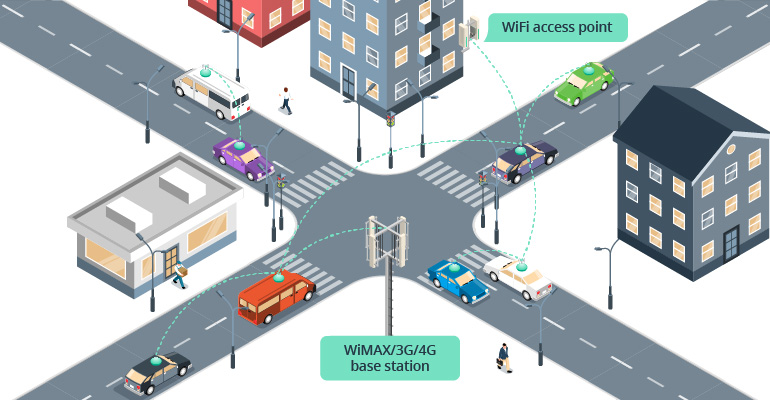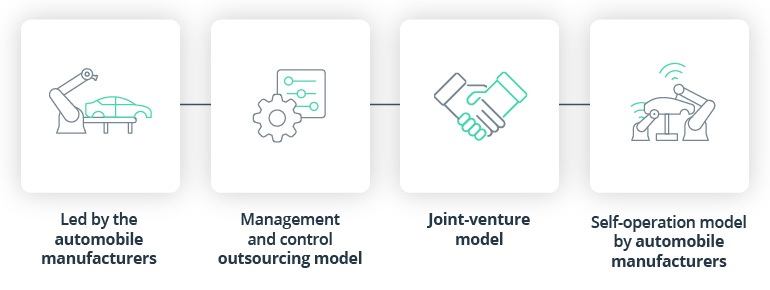The Internet of Things has spread to many industries, and new concepts have emerged from the unique blends of IoT technologies in certain fields. These are the harbingers of Industry 4.0, and the Internet of Vehicles (IoV) will be at the forefront of it. The Internet of Vehicles’ future seems bright and profitable, promising enhanced road safety, reduced environmental impact, efficient use of space, and cost management. But is that the reality? What lies under the surface of this concept? Let’s dive deeper.
In this article, you’ll learn:
- What is the Internet of Vehicles (IoV)?
- How IoV technology works
- IoV architecture
- How can we benefit from the Internet of Vehicles?
- What are the main IoV challenges?
- The future of IoV technology
- Automotive experience at Intellias
What is the Internet of Vehicles (IoV)?
The Internet of Vehicles is a network of connected cars, smartphones and wearables, roadside units, and a network of networks. The Internet of Vehicles relies on vehicle-to-vehicle (V2V), vehicle-to-human (V2H), and vehicle-to-infrastructure (V2I) connectivity. With IoV, every vehicle serves as a hub for both people and various IoT devices that are part of the traffic infrastructure. It influences transportation, manufacturing, energy, software, and other sectors.
IoV consists of hardware, software, services, and various network technologies, from Bluetooth and cellular to Wi-Fi and 5G, as well as different types of communication (V2V, V2X, etc.). There’s a lot of potential for OEMs, technology providers, mobile operators, and component vendors to claim their slice of the IoV pie. The global IoV market is estimated to grow at a CAGR of 18% from 2018 to 2024, reaching $208 million. Some governments — for instance, the Chinese government — are supporting the development of IoV technology. China is now one of the most important automotive markets in the world: The penetration rate and market of IOV [in China] will reach 22% and RMB 312 billion in 2020 respectively with a CAGR of 55.5%.
At present, money is going to Internet of Vehicles companies that provide software engineering and network services. Among the main global players are Ford, Audi, Intel, SAP, Apple, Google, IBM, and Cisco. It’s not strange that both traditional OEMs and tech giants are taking an interest in IoV. OEMs ceased to be “traditional” a few years ago, stirring more high-tech elements into their operational cocktails. Take Ford, Audi, and BMW: they have concentrated their efforts on solid tech partnerships to build smart cars with the advanced functionality demanded by modern consumers.
Condition monitoring systems, analytics software, third-party systems, location-based services, and multiple real-time apps are just a few examples of what today’s users expect to see in their vehicles. This is all part of the Internet of Vehicles (IoV) development.
Internet of Vehicles environment

Source: ResearchGate
How IoV technology works
The Internet of Vehicles has developed from the notion of a VANET — a vehicular ad hoc network — which was introduced as a combination of vehicle-to-vehicle and vehicle-to-infrastructure communication architectures. In IoV, each vehicle is an intelligent object with sensing platforms, control units, and multiple computing facilities connected to any entity via a V2X communication architecture.
VANET example

Source: Sciencedirect
IoV technology makes use of several communication channels depending on what a vehicle is communicating with:
- Intra-vehicle, where a car communicates with itself and provides an internal performance review
- Vehicle-to-vehicle wireless communication to capture data about each car’s speed, position, etc.
- Vehicle-to-infrastructure communication that allows cars to connect with roadside units
- Vehicle-to-pedestrian systems to gather data about people and cyclists near the road
- Vehicle-to-cloud communication for access to all information gathered via APIs
All these forms of interconnectivity shape a social Internet of Vehicles with multiple sensors gathering information across the modern smart city and guiding vehicles in real time.
IoV architecture
To understand how an IoV system operates, let’s break it into layers:
- Perception
- Network
- Application
Vehicular communication diagram

Source: Ercim-News
The first layer includes all the sensors within a car that collect information on events, the environment, and driving behaviors and patterns. The basis of IoV is a global ID terminal that has several applications: it serves as a communication gateway, a global positioning sensor, and an online identifier. The GID terminal provides connected vehicles with digital IDs and the background for using RFID tags.
The second layer is the communications layer, and it ensures connectivity with all networks. IoV applications have different service requirements, so various radio technologies have been fit in: DSRC, Wi-Fi, 4G and 5G, microwave, millimeter-wave, VLC, etc. IoV consists of heterogeneous networks with different users, requiring a centralized software-defined networking controller.
Software-defined networking (SDN) and network function virtualization (NFV) can ensure the integration of heterogeneous access technologies within IoV networks. SDN, NVF, and network slicing enable the operation of multiple wireless networks. Combined with artificial intelligence (AI) and data analytics, SDN/NFV-enabled IoV systems can ensure dynamic, complex, and heterogeneous networks with low latency, wide coverage, numerous connections, and high reliability.
The third layer of IoV is responsible for connected vehicle data analysis, storage, processing, and decision-making, bringing us to the question of benefits that IoV offers to consumers.
How can we benefit from the Internet of Vehicles?
The way IoV works with and reacts to the big data in the automotive industry can change the entire perception of today’s urban environments. It’s anticipated that IoV will be able to address the challenges of modern transportation while catering to the needs of tech-savvy consumers. It will become one of the backbones of smart cities, bringing the following perks:
- Enhanced safety
Human mistakes, namely distracted driving, are the primary cause of car accidents. IoV safety technology will ensure healthy driving habits, predict problems, detect possible collisions, track drivers’ health, and more.
- Positive impact on the environment
Smart infrastructure including connected and shared vehicles, streetlights, parking lots with sensors, and traffic and gas management technologies will significantly reduce vehicle emissions in big cities. Optimized routes and less congestion as well as more carsharing services and autonomous and electric vehicles will aid in creating a more sustainable future.
- Cost savings and lifecycle revenue
Both governments and individual users benefit from optimized city infrastructure and traffic management as well as safer roads and decision-making based on properly gathered and analyzed data. More than that, IoV makes way for the wider adoption of carsharing services and autonomous driving, which is a serious budget-saver for people and cities.
With the ability to process data gathered by connected vehicles, OEMs can create a whole new market of services. Knowing their customers better, automakers will be able to offer personalized deals, custom IoV solutions, paid advanced features, and more while partnering with financial institutions, retailers, and internet of vehicle software companies. As part of the IoV ecosystem, connected cars will be able to stand up to consumers’ expectations, offering a range of services from entertainment to in-car payments.
But despite a plethora of appealing advantages, IoV brings some new challenges to governments, drivers, pedestrians and Internet of Vehicles developers. Here are some of them.
What are the main IoV challenges?
Internet of Vehicles security challenges are first to come to mind. With the number of sensors and IoT devices connected into one network, it’s critical to investigate and implement security defense systems and privacy protection strategies right off the bat. This is a multilayered issue pertaining to regulations and compliance, robust protection of every connected device, advanced data encryption, user authentication, access, and so on.
Building IoV solutions that can withstand breaches and hacks is the task for IoV software developers, but who will explain security features and necessary security measures to consumers? Customer data ownership is another issue to deal with, as is the responsibility for cybersecurity of the entire IoV environment across multiple components and vendors.
One more thing that has to be considered is the long product lifecycle of the connected vehicle. It takes months to build a connected device, while creating a connected car takes years. However, consumers expect to leverage the latest tech when they buy a brand-new car. How can you manage to offer this when car technology is years older than device technology? The task is to ensure seamless scalability and integration, and this is quite a challenge for both OEMs and Internet of Vehicles software companies.
The future of IoV technology
As self-driving technology will soon be necessary for all automakers, presenting a $556 billion opportunity by 2026, IoV applications and solutions will only gain pace with time. Traditional OEMs are getting ready for innovation by transforming into IT-driven companies. Some automakers like General Motors and Volkswagen are opting for their own IoV software development in the fields of ADAS and networking systems. Other top automotive market players are partnering with tech giants like IBM, Google, Bosch, and Tencent. Telecom companies are also taking their place in the Internet of Vehicles’ future. Given that, new business models are emerging.
New business models enabled by IoV

Source: YCP Solidance
There’s still a lot to do to realize the Internet of Things future:
- Develop unified concepts and a unified scope of IoV nationwide
- Create protocols and standards for IoV software and hardware development
- Develop a secure, precise, and well-regulated navigation system
- Resolve IoV security challenges
- Establish ubiquity for all IoV network elements
- Learn to handle large data sets securely and reliably
- Overcome technical issues in cloud platform interfaces, network visualization, data mining and analysis, etc.
- Find a way to check compliance, licenses, and the credibility of vehicles remotely
- Enable new location-based service applications and IoV-tailored man-to-machine terminal interfaces
The road to IoV seems exciting, so let’s brace ourselves for the new challenges. At Intellias, we’re ready for what’s to come.
Automotive experience at Intellias
With years of experience in automotive software development, Intellias is moving the industry toward innovation one solution at a time. We’re already tapping into the potential of the Internet of Vehicles software solutions, developing tech for connected and autonomous cars:
- Vehicle-to-infrastructure software and cloud-based apps
- Remote vehicle control
- Navigation systems
- In-car software for autonomous driving
- Energy consumption control
IoV software development is starting now — from in-car systems and IoT wearables to smart city solutions and advanced data processing and analytics. The automotive market is already accepting the changes, but more industries have to follow to make the IoV concept real. The challenges are still numerous, but both budgets and initiatives are in place to help overcome them. Let’s look forward to a safer future with the Internet of Vehicles. Drop us a line to find out more about our steps in this direction.


